Learn how to make Futomaki or Maki Sushi, a traditional thick sushi roll filled with colorful ingredients. You can make this delicious and beloved sushi ahead of time and pack it for picnics, potlucks, and celebrations.
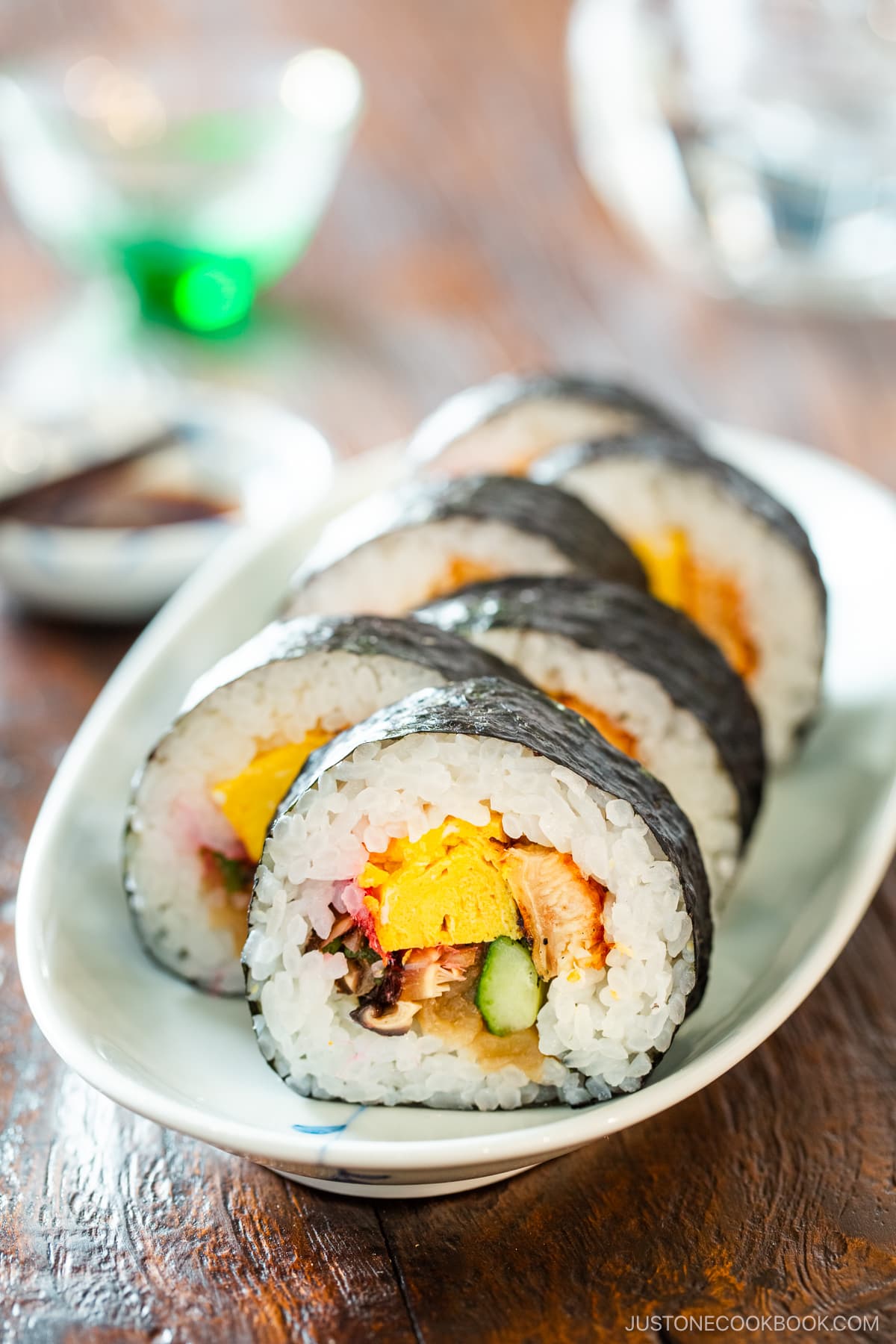
When I ask people what’s their favorite sushi, the answers I often get are some types of sushi rolls, like Dragon Roll, California Roll, or Spicy Tuna Roll.
In Japan, sushi usually implies the traditional style “nigiri sushi”, which consists of raw fish on top of the rice pillow. However, when we say sushi roll, it typically refers to Futomaki (太巻き)—a thick and fat sushi roll with colorful fillings.
Table of Contents
What is Futomaki?
Futomaki (太巻き) is the most classic sushi roll in Japan. Therefore, when you say Maki Sushi (巻き寿司) or sushi roll, it implies Futomaki. With its attractive look, Futomaki is a popular sushi roll for festivity events, holidays, potluck, or bento.
Here are some of the unique characteristics of Futomaki:
- The diameter is about 2 to 2.5 inches (5-6 cm) thick.
- It incorporates a mix of fresh and dried ingredients common in the Japanese pantry.
- The typical filling consists of various vegetables, sometimes with cooked fish like unagi (freshwater eel) or anago (saltwater eel).
- It can be prepared ahead of time.
By the way, the word “Maki Sushi” is often used in the Osaka area. In the Tokyo area, sushi roll is called Nori Maki (海苔巻き). It is then further divided into Futomaki (太巻き), Chumaki (中巻き), Hosomaki (細巻き) based on the size of the rolls.
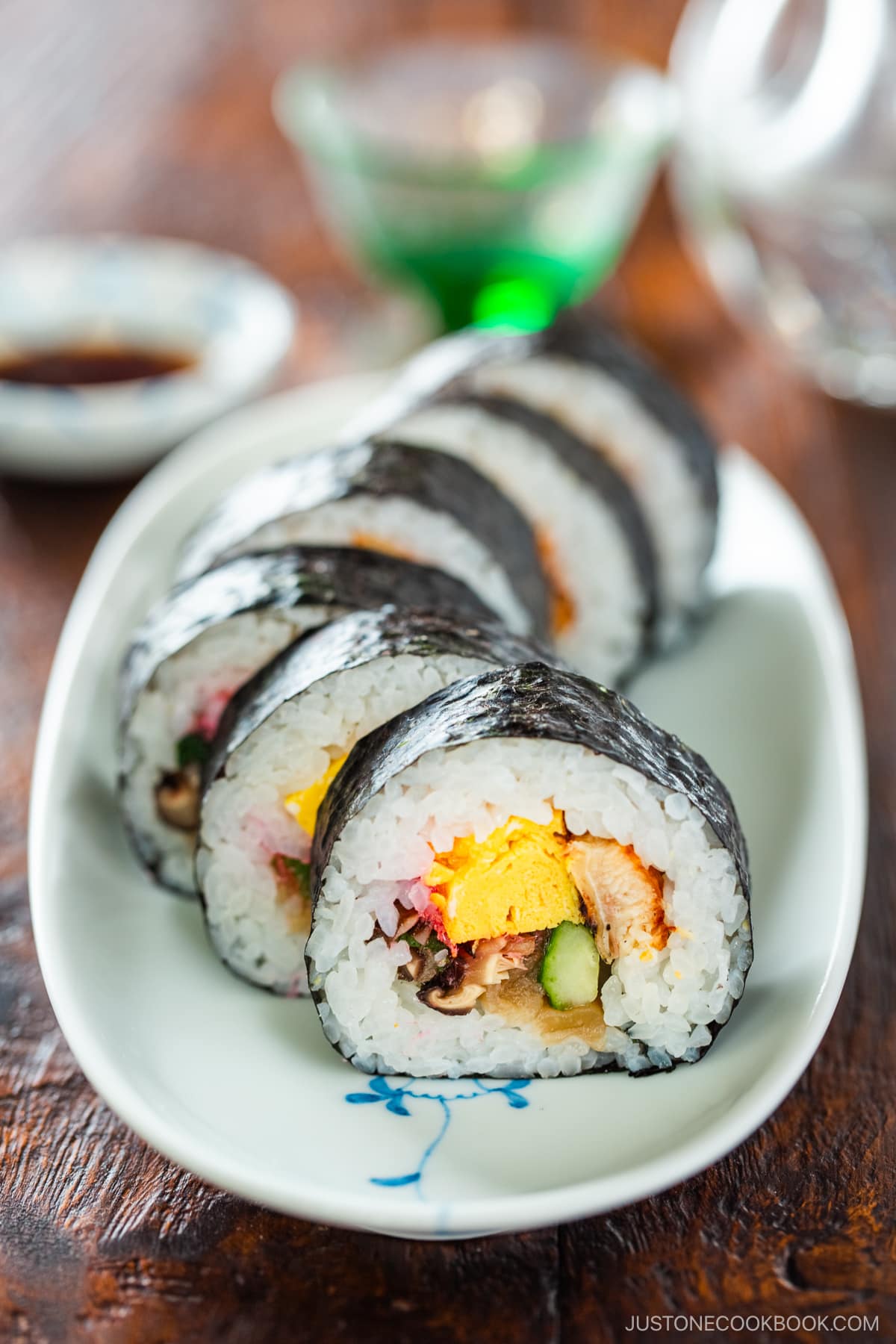
What’s Inside Futomaki (Maki Sushi)?
Each family chooses different fillings for futomaki. Some people use 5 ingredients and some include more than 10. It really depends on the family. And that is what makes Futomaki such fun sushi to share!
The most common ingredients include cucumber, seasoned kanpyo (gourd strips), shiitake mushrooms, and tamagoyaki (Japanese rolled omelette).
In my rolls, I include the following 7 ingredients:
- Tamagoyaki / Dashimaki Tamago
- Simmered Kanpyo (gourd strips)
- Simmered Shiitake Mushrooms
- Mitsuba or Spinach
- Cucumber
- Cooked unagi (freshwater eel) or anago (saltwater eel)
- Sakura Denbu (Seasoned Codfish Flakes)
Other ingredients include kamaboko fish cakes (or imitation crab), koyadofu (freeze-dry tofu), shiso leaves, pickled ginger, carrots, tuna (sashimi), and salmon (sashimi).
I understand some of these ingredients are hard to find in your local Asian grocery stores. You will have better luck finding the products in Japanese grocery stores.
But remember, you can make futomaki with anything that you really like! Just keep in mind that the flavors should balance each other, and not have any single ingredient overpowering the rest.
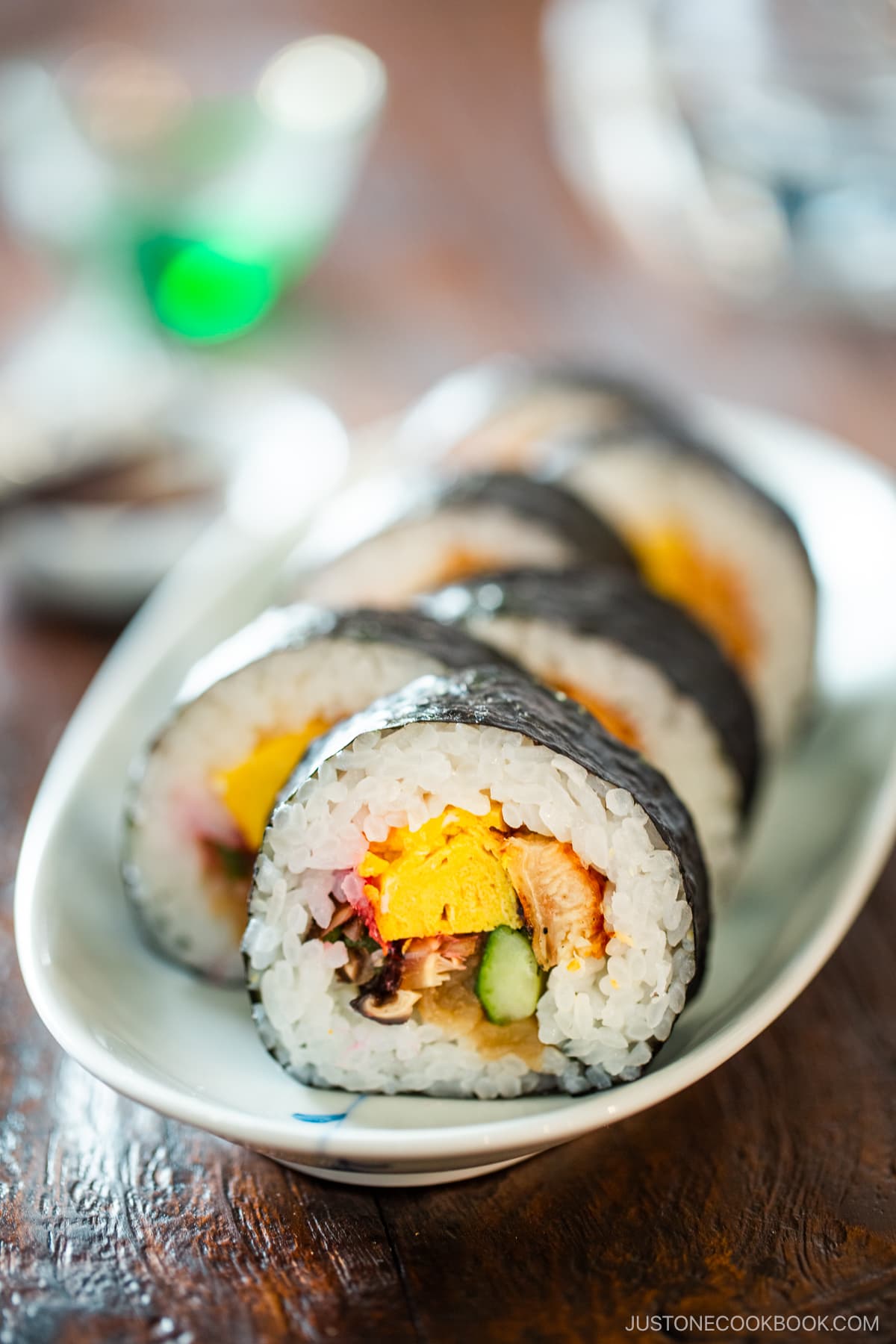
Where to Buy a Sushi-Making Kit
If you want a full kit that has everything you need to make sushi at home, I recommend the JapanBargain Sushi Making Kit. It comes with a hangiri and is my favorite sushi making kit. It’s just $26.99 at Amazon and comes with three mats and three rice paddles, so you can make multiple rolls at once.
Interesting Fact: Maki Sushi Turns into “Ehomaki” on February 3
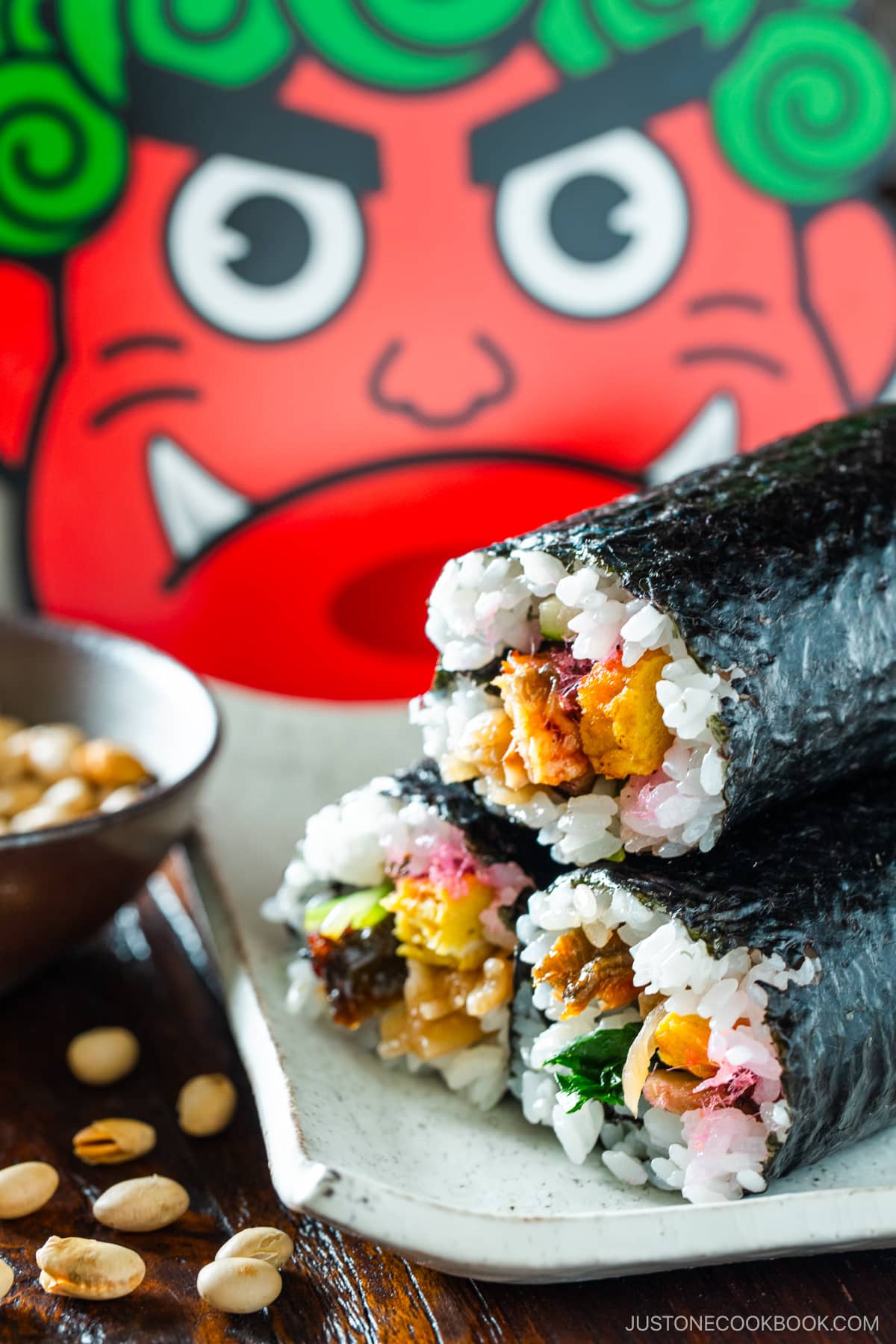
The Japanese call this sushi roll futomaki all year round, except for one day out of the year.
On February 3rd, the day of Setsubun (節分, the day before the beginning of spring in Japan), the same sushi roll is called ehō-maki (恵方巻).
What is Ehomaki?
Ehōmaki (恵方巻) is eaten uncut, like a burrito, and you would eat it while facing the lucky direction (the eho). This lucky direction changes every year depending on the zodiac symbol.
For 2024, the lucky direction is east-northeast.
It is said that it is good luck to use seven kinds of filling in honor of the Seven Lucky Gods (七福神), but more and more people are enjoying using a variety of toppings to suit their tastes, without worrying about the number of ingredients.
There are several rules for eating ehomaki that are designed to bring you good luck. “Eating in silence” is one of them. This is because various ingredients (symbolizing good fortune) are wrapped around ehomaki, and it is said that if you talk while eating, you will lose your good fortune.
This rule seems easy to follow when you’re enjoying ehomaki alone, but be careful when you’re with family or friends!
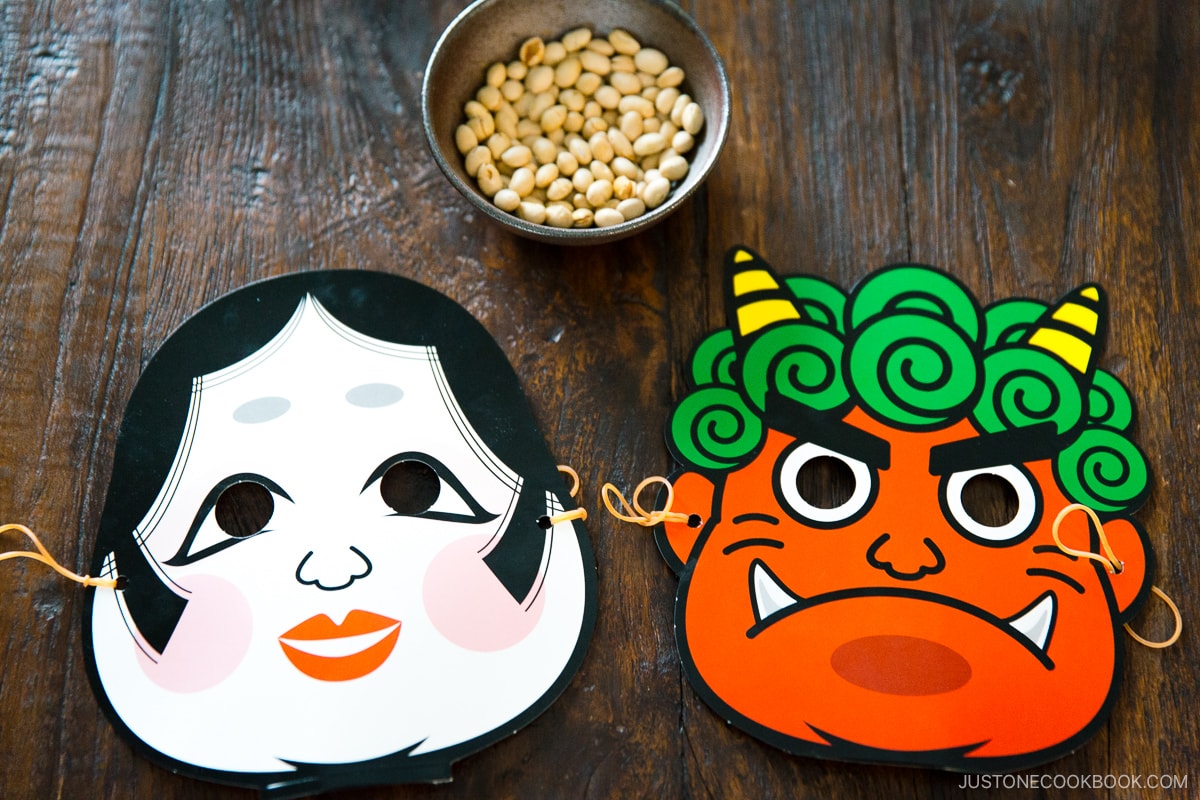
On the evening of Setsubun, we have a custom of throwing roasted soybeans around the house, and outside from the window while shouting “Oni wa soto! Fuku wa uchi!” (“Devils out, happiness in”).
These beans are called Fuku Mame (fortune beans) and the bean-throwing ceremony is called Mame Maki. Afterward, everyone eats the same number of beans as their own age, wishing to be free of sickness during that year.
If you are interested in learning about Setubun, check out Setsubun: The Japanese Bean Throwing Festival.

More Sushi Recipes You’ll Like
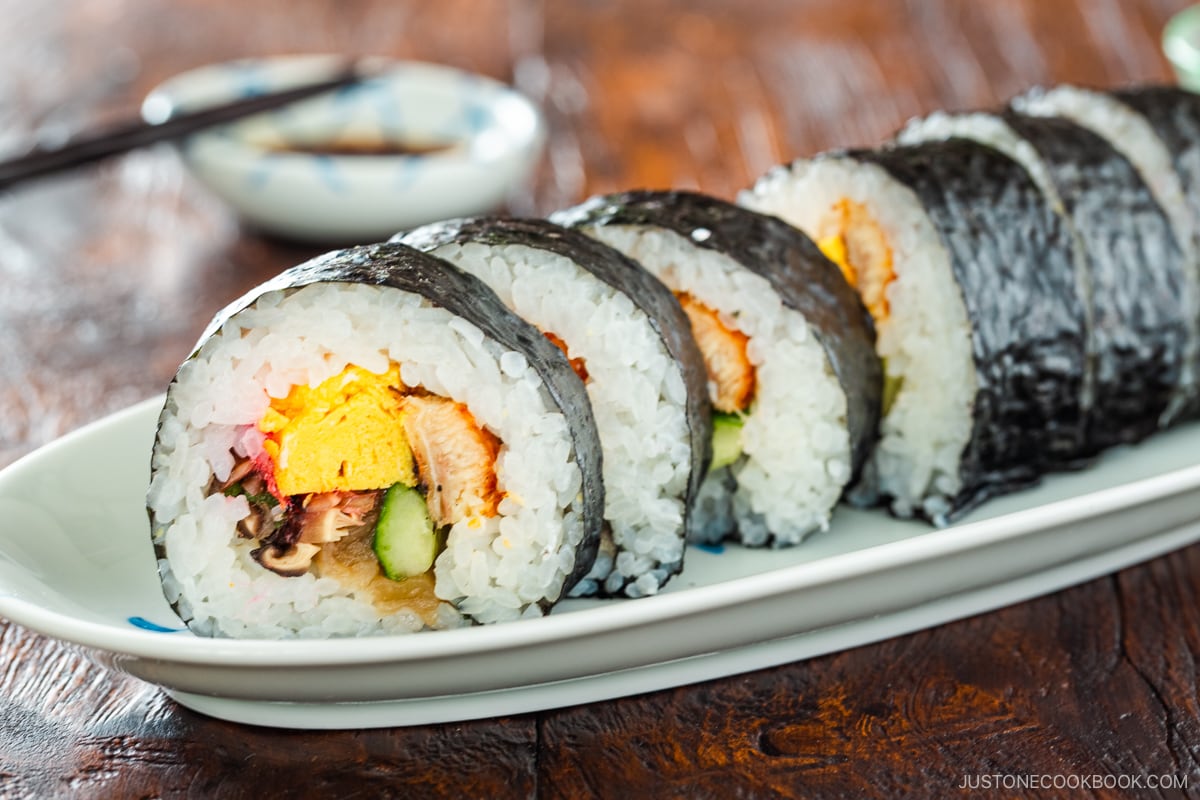
Wish to learn more about Japanese cooking? Sign up for our free newsletter to receive cooking tips & recipe updates! And stay in touch with me on Facebook, Pinterest, YouTube, and Instagram.
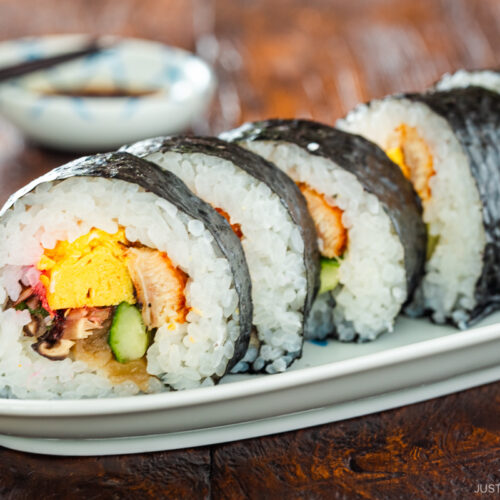
Futomaki (Maki Sushi / Ehomaki)
Ingredients
For the Sushi Rice
- 2¼ cups uncooked Japanese short-grain white rice (3 rice cooker cups, 540 ml; do not use brown rice; see Notes)
- 2¼ cups water (540 ml)
- 1 piece kombu (dried kelp) (5 g; 2 x 2 inches or 5 x 5 cm per piece; optional, for a nice aroma!)
- ⅓ cup rice vinegar (unseasoned) (you can substitute pre-seasoned bottled sushi vinegar)
- 3 Tbsp sugar (skip if using bottled sushi vinegar)
- 1½ tsp Diamond Crystal kosher salt (skip if using bottled sushi vinegar)
For the Filling
- seasoned shiitake and kanpyo (see the instructions; you can make it up to 2 days in advance and refrigerate)
- 1 Tamagoyaki (Japanese Rolled Omelette) (make either Tamagoyaki or sweeter Atsuyaki Tamago; you can make it ahead and refrigerate)
- 1 handful of mitsuba (Japanese parsley) (or spinach)
- 1 unagi (freshwater eel) fillet (broiled)
- 1 Japanese or Persian cucumber
- 1 package sakura denbu (seasoned cod fish flakes) (1.4 oz, 40 g)
For the Seasoned Shiitake and Kanpyo
- 8 dried shiitake mushrooms
- 1 cup water (for soaking)
- 0.4 oz dried kanpyo (gourd strips)
- 1 tsp Diamond Crystal kosher salt (for the kanpyo)
- 1 Tbsp sugar
- 1 Tbsp mirin
- 1 Tbsp soy sauce
For Rolling the Futomaki
- ¼ cup water (for tezu finger dipping water)
- 2 tsp rice vinegar (unseasoned) (for tezu)
- 4 sheets nori (dried laver seaweed)
For the Garnish
- sushi ginger (gari) (optional; you can make pickled sushi ginger at home)
Instructions
To Prepare the Sushi Rice
- It takes about 90 minutes to make sushi rice. Please follow my Sushi Rice recipe for step-by-step instructions on how to cook the rice and add the sushi seasoning. For this recipe, use 2¼ cups uncooked Japanese short-grain white rice, 2¼ cups water, and 1 piece kombu (dried kelp) to cook the rice. For the sushi seasoning, use ⅓ cup rice vinegar (unseasoned), 3 Tbsp sugar, and 1½ tsp Diamond Crystal kosher salt. Cover the prepared sushi rice with a damp cloth at all times to prevent drying.

To Make the Seasoned Shiitake and Kanpyo
- In a bowl or measuring cup, add 8 dried shiitake mushrooms and 1 cup water and let them soak for 15 minutes. Place a smaller bowl on top to keep the mushrooms submerged.

- In a small saucepan, bring some water to a boil. Quickly rinse 0.4 oz dried kanpyo (gourd strips) in running water and drain. Rub the kanpyo with 1 tsp Diamond Crystal kosher salt. Rinse and drain well.

- When the water is boiling, cook the kanpyo for 3 minutes. Transfer to iced water to stop the cooking process. Squeeze out the water.

- When the shiitake are soft and tender, cut off and discard the stems. Strain the soaking liquid through a fine-mesh sieve to get rid of any debris.

- Reserve this shiitake stock, adding water if needed until you have 1 cup (240 ml) of reserved shiitake stock.

- In a medium saucepan, add the kanpyo, mushrooms, and reserved shiitake stock.

- Add 1 Tbsp sugar, 1 Tbsp mirin, and 1 Tbsp soy sauce to the saucepan.

- Bring it to boil. Then, lower the heat to medium and cook until most of the liquid is gone, about 20–30 minutes.

- Cut the shiitake mushrooms into very thin slices and squeeze the water out.

- Squeeze the water out from the kanpyo and cut it into 8-inch (20-cm) lengths, which is about the same width as the nori sheet.

- Now, the seasoned shiitake and kanpyo are ready to use. You can make this ahead of time and store them in the refrigerator for a couple of days.

To Make the Tamagoyaki
- Make 1 Tamagoyaki (Japanese Rolled Omelette) using either my standard Tamagoyaki recipe or sweeter Atsuyaki Tamago recipe.

- Cut the tamagoyaki into long strips. You can make it ahead and keep it in the refrigerator until ready to use.

To Prepare the Unagi (Eel)
- Unagi is typically pre-cooked and broiled when you purchase it, so you just need to reheat it. Set your oven broiler to High (550ºF/290ºC) and preheat it for 3 minutes. Meanwhile, line a baking sheet with aluminum foil and spray it with oil. Place 1 unagi (freshwater eel) fillet on top. Broil on the oven‘s middle rack for 5–7 minutes (no need to flip). Cut it into 4 long strips. Set aside.

To Prepare the Mitsuba or Spinach
- Tie the stems of 1 handful of mitsuba (Japanese parsley) or spinach together with cooking twine to keep them bundled while cooking. Bring a pot of water to a boil. Add 1 tsp salt and blanch the mitsuba or spinach just until tender. Do not overcook.

- Soak the blanched mitsuba in iced water and squeeze the water out. Set aside.

To Prepare the Cucumber
- Cut off the ends of 1 Japanese or Persian cucumber. Cut into quarters lengthwise and remove the seeds. Set aside.

To Prepare the Sakura Denbu (Seasoned Cod Fish Flakes)
- Open 1 package sakura denbu (seasoned cod fish flakes) and put it in a small bowl. Set aside.

To Assemble the Futomaki
- Gather all the ingredients. Prepare tezu (finger dipping water) by combining ¼ cup water and 2 tsp rice vinegar (unseasoned).

- Place a bamboo sushi mat on the work surface. Gather 4 sheets nori (dried laver seaweed). Place one sheet of nori on the bamboo mat, shiny side down. Divide the sushi rice into 4 portions. Dip your fingers in the tezu. Then, put one portion of the sushi rice on the nori and use your wet fingers to spread it evenly (so your sushi looks centered when cut).

- Leave a ½-inch (1.5-cm) strip along the top of the nori farthest away from you. This empty strip makes the Futomaki look attractive because it keeps the rice from showing at the seam when rolled.

- Place a cucumber strip on the sushi rice along the width and toward the bottom of the nori (closest to you). You will roll the ingredients at the bottom OVER the rest of the filling. Therefore, I recommend putting easy-to-hold ingredients, like cucumber, toward the bottom. Place the Sakura Denbu and Shiitake toward the top so these smaller pieces won’t fall out as you roll.

To Roll the Futomaki
- Using your fingers to hold the ingredients in place, start rolling the bottom end of the nori sheet over the filling. Use the bamboo mat to roll tightly and firmly until the bottom edge of the sushi rice meets the rice on the other side of the ingredients.

- With one hand, firmly hold the mat with the rolled portion in place. With your other hand, grab the top end of the mat. Then, pull the two against and away from each other to tighten the roll. Next, lift the bottom end of the bamboo mat from the roll and finish rolling the rest of the way. Finally, remove the bamboo mat, place it over the roll, and squeeze firmly. Set your completed sushi roll on a tray or large plate. Continue to make the rest of the rolls.

To Cut and Serve
- Using a very sharp knife, first cut the Futomaki crosswise in half. Then, wipe the knife with a wet kitchen cloth so that you can make clean cuts. Wipe your knife after every slice or every other slice.

- Then, cut each half into 3 pieces. Serve with sushi ginger (gari) on the side. Enjoy!

To Store
- It‘s best to enjoy sushi rolls on the same day you make them. Rice gets hard and dry in the refrigerator. Therefore, if you really want to keep sushi rolls in the refrigerator, my recommendation is to cover them with plastic and then with a thick kitchen towel, so the rice will stay cool and safe, but not get cold.
Notes
- Rice: 1 US cup (240 ml) is not the same as 1 rice cooker cup (180 ml). 1 US cup of cooked rice weighs 6.3 oz (180 g). One thick sushi roll requires 1⅔ cups (250 g) of sushi rice. Please use short-grain white rice for sushi. Brown rice is not ideal for making sushi.
- Sushi Vinegar: There is a convenient Sushi Seasoning available at a Japanese/Asian grocery store.
Nutrition
Editor’s Note: The original post was published on January 30, 2016. The post has been updated in January 2020.
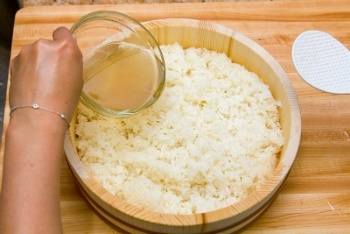
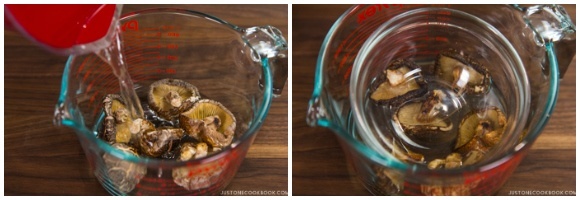


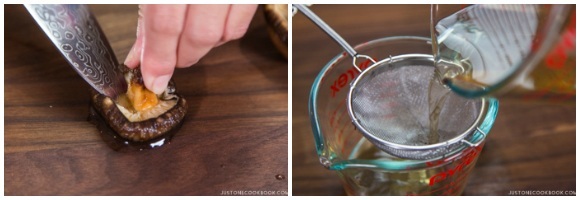
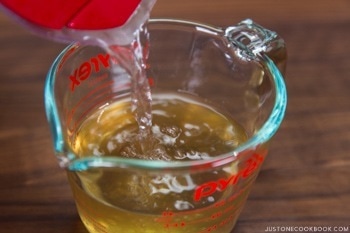
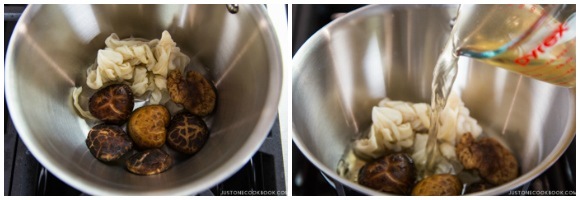


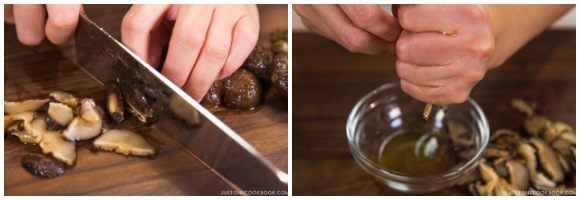
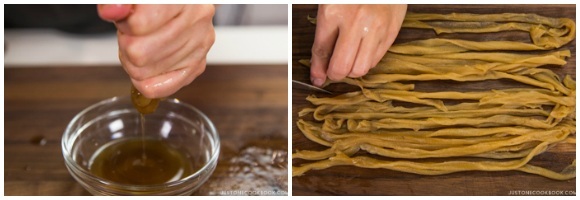
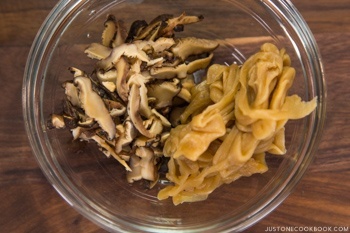
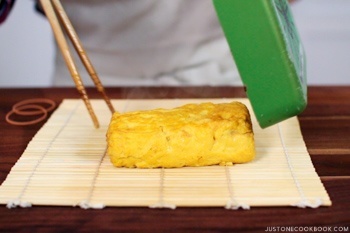
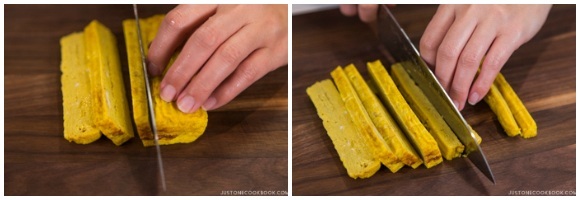
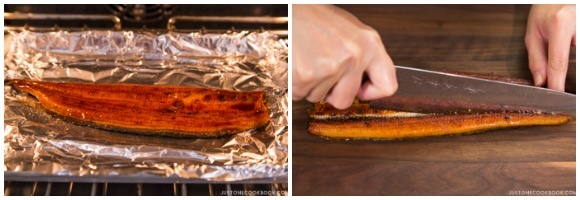
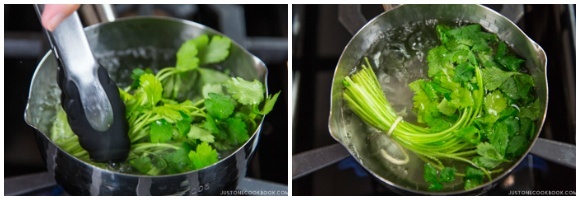
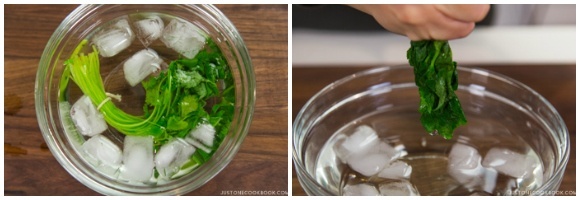
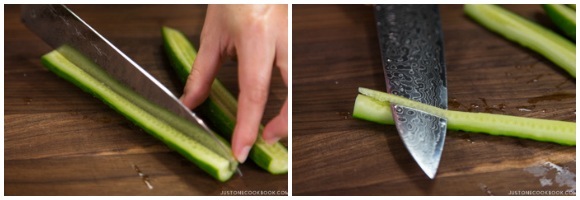
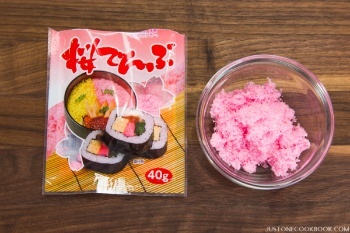
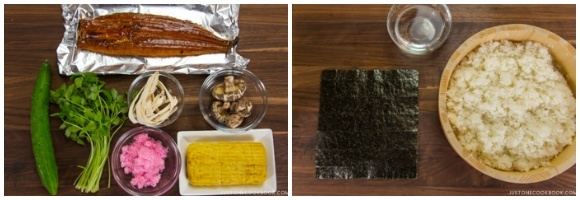
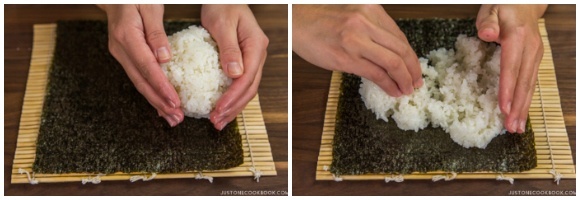
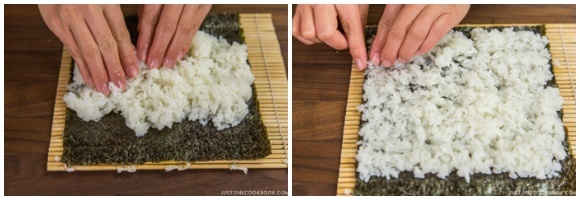
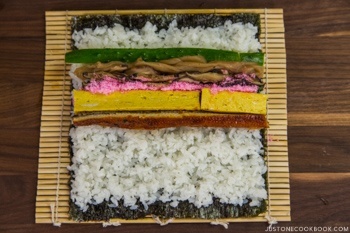
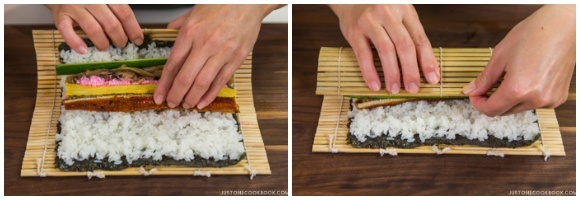
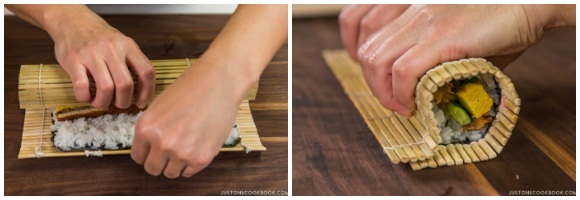
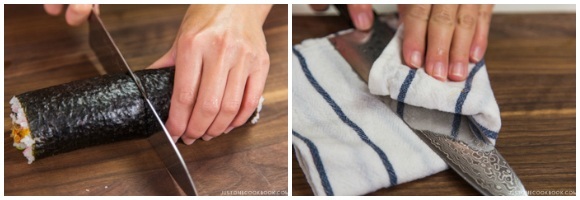
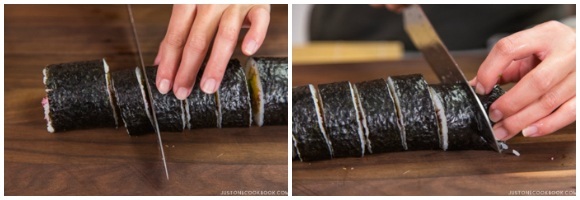











Hi, would it be possible to make futomaki with cooked fish in advance to eat the next day for a bento lunch? How to store and how long would it last?
Hi E K, Thank you for reading Nami’s post and trying her recipe!
Yes, if you make them the night before, you can pack them for Bento and eat them within 24 hours of making them. To keep the moisture in, cover the Futomaki with parchment paper and store it in the refrigerator with a wet paper towel or plastic wrap.
We hope you found this information useful!
[…] denbu is colored pink like cherry blossoms and is sprinkled over rice bowls or rolled in futomaki. It’ll add a spring touch to any […]
[…] Futomaki 太巻き […]
[…] of calabash (a type of gourd). These long, thin dried strips are commonly used as an ingredient in futomaki, a traditional thick sushi roll, and other sushi menus. You can also find them being used […]
[…] uses, such as a garnish in miso soup, rice bowls, noodle dishes, chawanmushi, an ingredient in futomaki, or folded into tamagoyaki. An herb native to northern China, Korea, and Japan, all parts of the […]
How do you keep norI when making sushi crispy. Mine always get rubbery?
Hi Agnes! Sushi roll’s nori is never crispy. When you use good quality nori, the texture won’t be rubbery. So try to get good nori although it might be more expensive… you will notice the difference. 🙂